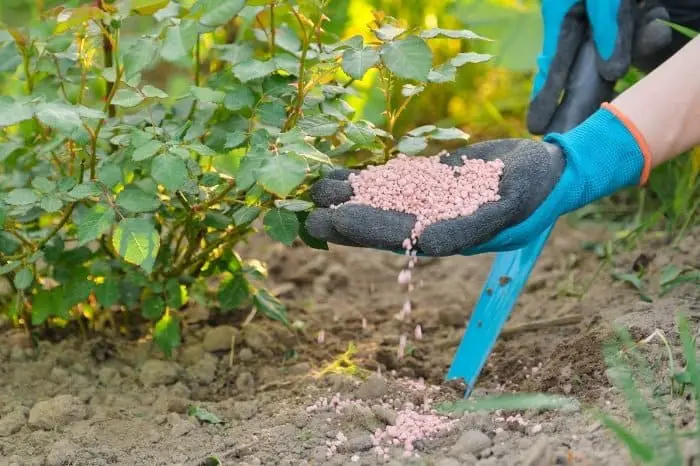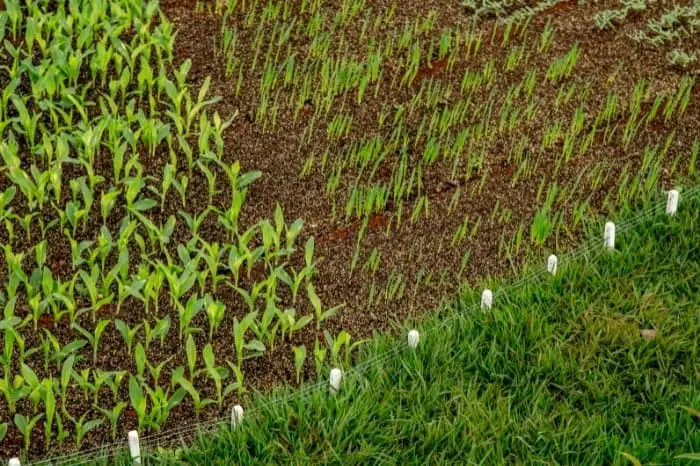Last Updated on March 21, 2023
Supplying your plants the appropriate level of potassium is beneficial to their growth. A bit of extra potassium isn’t too bad; however, too much potassium in plants can be pretty detrimental to them.
This is why you need to know the amount of potassium needed by plants. You also need to know how to reduce potassium in soil whenever there’s an issue of excess addition in order to save your plants.
So, let’s dive in and talk about problems caused by too much potassium, how to solve excess potassium in the plants’ soil, the benefits of potassium in the soil, and more.
Potassium Soil
A soil that has a healthy amount of potassium will experience plant flourishing. It is an important nutrient component required for the optimal growth of plants. Potassium is a macronutrient and it is the third value in the NPK (Nitrogen, Phosphorous, and Potassium) ratio.
Potassium helps with photosynthesis and will enhance the rigidity of plants and also helps with disease resistance. It will also help with the drought or stress that your plant may experience.
Potassium should be supplied in the correct amount and a little extra amount may be fine. But when it gets too much, it will lead to issues that will cause nutrient deficiency.
Generally, the right quantity of potassium level should range from 40 to 80 ppm.
Too Much Potassium In Plants Soil
When potassium in plants becomes too much, it interrupts the absorption of vital nutrients such as magnesium, calcium, nitrogen, and so on. This in turn will lead to a deficiency in nutrients which will be a risk to your plants’ development.
The first signs you will notice when there is excess potassium present in the soil is:
- The leave veins may begin to show a red color patch.
- The older growth of the lower stem will start to experience yellowing of foliage and the rest of the leaves remain light green.
To detect or confirm excess potassium in your plant soil, simply have your soil tested. This is the only accurate way of confirming excess potassium in plants. Garden testing kits can be used to test excess potassium in soil and they can be purchased at your local garden or nursery center.
Luster Leaf 1601 Rapitest® Soil Test Kit
How To Lower Potassium In Soil
The following things can be done to relieve the presence of excess potassium in plant soil:
- Dilute With Water Addition: Loosen the soil with a shovel and add water to dilute and remove excess potassium in the soil. After doing this, let the soil dry totally and repeat the flushing process two or three times more.
- Use Low Potassium Fertilizer Contents: When you are purchasing your fertilizer, the products you’re buying have the main macronutrients listed out. These main macronutrients include nitrogen (N), phosphorus (P), and potassium (K). So, to decrease potassium in plant soil, go for products that contain a low amount or zero amount of potassium (K). Note that in this case, your plant will do well without potassium.
- Plant Cover Crops: Cover crops of legumes can also help as they will increase nitrogen fixation. This will only boost the nitrogen level without increasing potassium or phosphorus level.
- Use Organic Manure: The ratio of NPK in organic fertilizers is usually low. Chicken manure for example has an NPK of 4:3:3. The nutrients in manure also decompose slowly which can reduce potassium build-up.
- Remove Rocks or Stones: Rocks contain minerals such as mica and feldspar rich in potassium. Therefore, separate and remove as many stones or rocks as possible to prevent them from releasing their minerals into the soil.
- Mix Crushed Eggshells With Soil: If you are making use of a small area, mix and dig in mussel shells or broken eggshells into the soil. This can assist in balancing nutrients in the soil. Wood ash or soft phosphate can also be added to the soil to improve calcium rather than potassium.

Preventive Measure
Constant monitoring or testing your soil can help detect early if there is any excess nutrient in the soil. If your soil tests enough or high potassium level, you should refrain from adding more fertilizers that may contain potassium.
Another thing you can do if you already have enough potassium levels in your soil is to always choose nutrient products low in potassium.
Benefits Of Potassium In Plants
The macronutrient potassium (in the right quantity) is essential to plants in many ways and growers rely on potassium for healthy crop production. Below are the benefits of potassium in plants:
- In plants, the movement of nutrients, water, and carbohydrates is connected with potassium.
- Potassium will help enhance the size and quality of vegetables and fruits. Thus, it is essential for edible foods.
- It is used as a regular fertilizer scheme in lawns, gardens, and orchards. It also enhances the blooming of roses and other flowering plants and enhances strong stems and developed flowers.
- The plant cell that controls water is regulated by potassium. Potassium will as well aid some enzymes in a plant cell.
- Deficiency in potassium will cause plants to be unable to convert nutrients into nutrients required by roots, leaves, and fruits.
- Potassium will also assist plants in water usage and it will help with drought or stress experienced by your plants. Thus, saving your plants from diseases and heat stress.
- Enzymes activation in plants requires potassium and it helps with the production of starch, protein, as well as ATP. ATP production helps regulate the rate of photosynthesis.

FAQ’s
What are the effects of too much potassium in plants?
Potassium is a mineral, one of the most common minerals in the Earth's crust. It is an essential part of plant life, and all living things need it to grow. Plants absorb it through their roots and use it to make plant cells function properly. Some plants take up potassium in quantities far greater than other plants, but they can't store it in their cells like other plants. So what happens when these plants take up too much potassium?
So what happens when these plants take up too much potassium? They grow more slowly, or not at all.
What are the symptoms of potassium in plants?
Potassium is a mineral that is necessary for plant growth, according to the University of Maryland Extension. Potassium helps control the size of the plant, maintain healthy and strong roots, increase resistance against stress, and create energy reserves. Keep Learning The level of potassium in the soil is the first thing that needs to be considered when planning to grow plants.
Plants that are deficient in potassium will have leaf yellowing, wilting or other signs of illness. Potassium is also a component of chlorophyll, which is what makes plants green.
How do you fix too much potassium in soil?
The most common way to correct this is to apply a slow release fertilizer that will be available for a longer period of time. In the case of potassium, I use something like Potashite which is a slow release fertilizer that releases potassium at a rate of about 0.5 lbs per 1000 sq. ft. over a 3 year period. Another option is to add wood ash to your soil.
Wood ash contains potassium, magnesium, calcium and phosphorous. I would recommend adding a small amount at first until you see how much it grows, then add more if you need it. The amount that you need will depend on the size of the plant.
Conclusion On Too Much Potassium In Plants
There is no disputing the importance of potassium in the development of plants generally. However, you need to be aware of the right amount to supply your plant soil. Too much potassium in plant’s soil can be pretty detrimental to their growth.
Ensure you always test your soil with the right testing tools especially when you want to apply your NPK fertilizer. When you notice you have a high level of potassium, you should make use of fertilizer with a low or zero potassium ratio.

Eunice is an enthusiastic gardener with a passion for growing beautiful flowers. She loves nothing more than spending time in her garden, tending to her plants and enjoying the outdoors. Eunice has been gardening for over 15 years and has developed a unique style of landscaping that is both practical and aesthetically pleasing. She is especially fond of growing roses and enjoys experimenting with different varieties and colors. Eunice takes great pride in her garden and often shares the fruits of her labor with friends and family. In her spare time, she enjoys reading gardening magazines and attending local horticulture events. Eunice is passionate about her hobby and is always eager to share her knowledge and experience with others.

